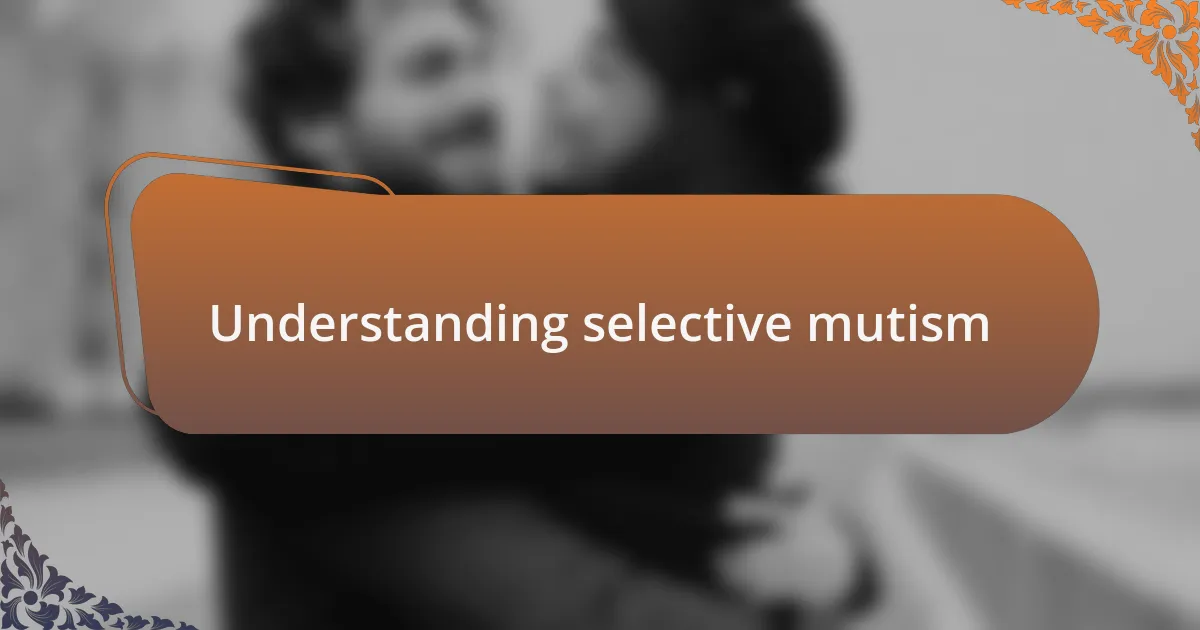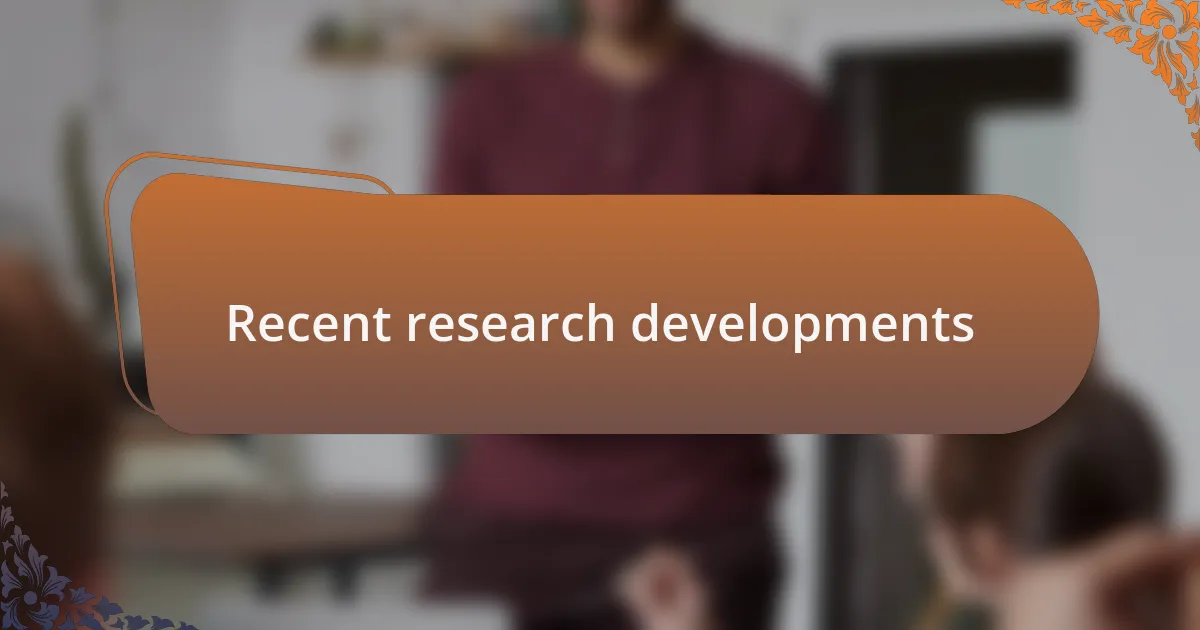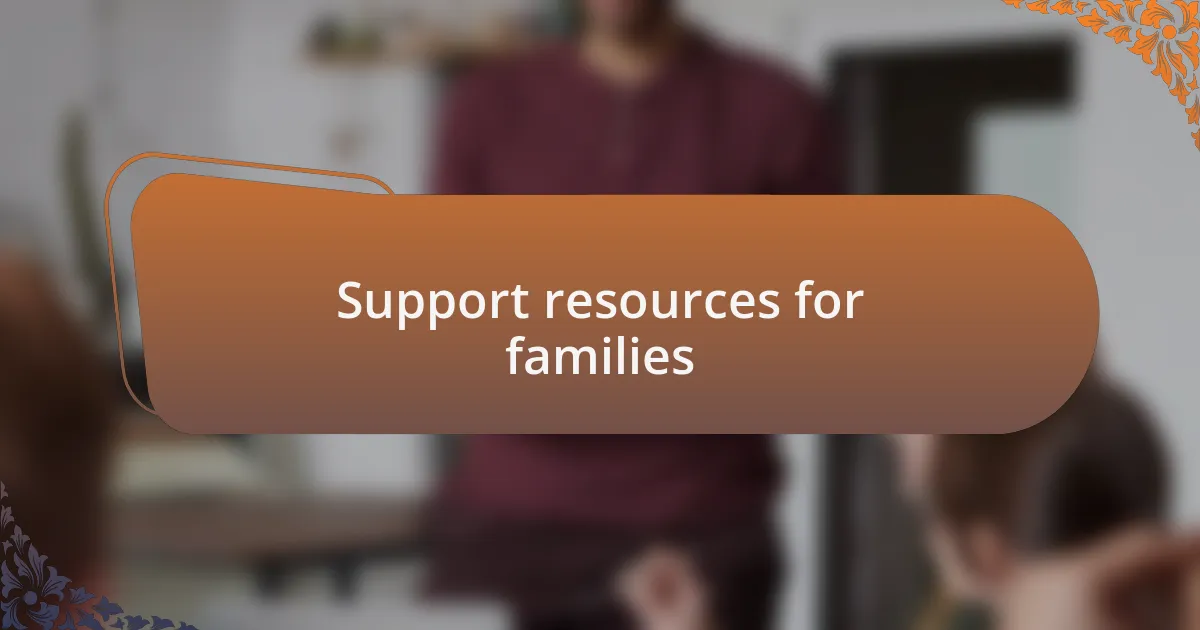Key takeaways:
- Selective mutism is a complex social anxiety that affects children’s ability to speak in certain situations, leading to misconceptions about their behavior.
- Raising awareness about selective mutism is crucial for fostering empathy, support, and understanding in social and educational environments.
- Recent research emphasizes the importance of early intervention and innovative therapeutic approaches, which can significantly enhance communication skills and self-esteem.
- Effective communication strategies include non-verbal methods and creating safe spaces for expression, which can aid individuals with selective mutism in sharing their thoughts.

Understanding selective mutism
Selective mutism is often misunderstood, and I can personally relate to how isolating it feels. Imagine wanting to speak but feeling a tidal wave of anxiety wash over you instead. This condition goes beyond mere shyness; it’s a complex social anxiety that can paralyze a child in specific settings, such as school or social gatherings.
Every time I reflect on my experience with selective mutism, I remember the feeling of being trapped in silence while others effortlessly engaged in conversation around me. Can you picture what that must be like? Children with selective mutism may be perfectly capable of speaking at home but feel suddenly mute in unfamiliar environments. It shows just how intricately emotions and communication intertwine.
What can be especially challenging is that those who don’t understand this condition might mistakenly label these children as rude or aloof. However, deep down, many of them are eager to interact but are overwhelmed by fear. It’s crucial for us to recognize that selective mutism is not a choice but a struggle. We need to foster empathy and understanding so everyone can navigate their challenges more comfortably.

Importance of raising awareness
Raising awareness about selective mutism is vital because it helps to dispel the misconceptions surrounding this condition. I remember an incident where a teacher assumed my quietness was defiance rather than an expression of my struggle. This misunderstanding not only magnified my anxiety but also created barriers to forming connections with peers. How tragic it is that a simple lack of awareness can lead to such misinterpretations!
When awareness increases, it paves the way for more supportive environments. Families, teachers, and friends can learn to recognize the symptoms and offer compassionate responses, which I believe is crucial in easing the burden on those affected. Have you ever seen someone thrive simply because they felt understood? It’s powerful how empathy can transform the way children approach communication.
Moreover, raising awareness encourages open conversations about mental health. When society begins to comprehend the complexities of selective mutism, it empowers those struggling to seek help and fosters a sense of community. I find this particularly important; if I had known there were others like me, perhaps my journey would have felt less solitary. By sharing knowledge, we can help create pathways for healing and connection.

Recent research developments
Recent studies have begun to shed light on the neurological aspects of selective mutism, revealing potential underlying factors that contribute to this condition. For instance, I recently read about a fascinating study exploring the brain’s response to social cues in children with selective mutism. It highlighted how their brain activity differs from those who are more verbally expressive—a revelation that gave me a deeper understanding of my own experiences and struggles.
Additionally, researchers are investigating innovative therapeutic approaches tailored to children with selective mutism. One method I came across involved gradual exposure to speaking situations, which sets the stage for anxiety reduction. I vividly recall my own childhood when such supportive strategies could have made navigating social environments much less daunting. Wouldn’t it be encouraging to know that these fresh approaches could potentially ease the journey for future generations?
Moreover, recent research emphasizes the importance of early intervention. Evidence suggests that timely support not only improves communication skills but also significantly boosts children’s self-esteem. I often wonder how my life might have been different had I received intervention at a younger age. It’s thrilling to think that as awareness grows, so do the opportunities for effective support, promising brighter futures for those affected.

Personal experiences with selective mutism
I remember a moment in elementary school that still resonates with me. I sat in class, paralyzed by the thought of speaking aloud during group discussions. My heart raced, and I felt an overwhelming urge to blend into the background, as if becoming invisible would shield me from the anxiety of being called on. Why did it feel so easy for others to express themselves while I felt trapped? It was a struggle that many of my peers simply couldn’t understand.
During family gatherings, I often found myself in a silent battle, wanting to participate but feeling utterly voiceless. I recall my grandmother’s kind smile when I finally whispered a few words, her encouraging nod only amplifying my self-doubt. Would others notice my fear? This made me question whether they even realized I was supposed to respond. These experiences shaped my perspective, illustrating how selective mutism isn’t just about the inability to speak; it’s woven into the fabric of social interactions and emotional well-being.
There were days when I would muster the courage to speak—tiny victories felt monumental. I remember the first time I spoke to a teacher after weeks of silence, and how proud I felt for breaking the unspoken barrier. Yet, it also left me pondering: Why did something so simple for many feel like climbing a mountain for me? These moments of breakthrough were significant, yet they often came with the haunting pressure of trying to maintain that progress in a world that always seemed too loud and overwhelming.

Strategies for effective communication
Effective communication with individuals experiencing selective mutism can be incredibly rewarding yet challenging. One strategy that proved invaluable in my journey was the use of non-verbal communication. I often relied on gestures, facial expressions, and even visual aids like drawings to express myself. This approach not only alleviated some stress but also allowed me to convey my thoughts without the pressure of speaking.
Another technique that worked well for me involved creating a safe space—literally and figuratively. In settings where I felt comfortable, like at home or with close friends, I found it easier to share my thoughts. I would often suggest activities that encouraged interaction without the spotlight, like group games or art projects, where the focus was on the task rather than on speaking. Have you found environments where you feel more at ease?
Moreover, initiating conversations through gentle prompts can be a game-changer. I recall moments when a simple, open-ended question like, “What do you think about this game?” allowed me to engage without feeling overwhelmed. These small interactions fostered a sense of belonging and made communication feel less daunting. Building those connections took time, but they paved the way for my eventual willingness to voice my thoughts aloud.

Support resources for families
Support resources for families can make a significant difference in navigating the challenges of selective mutism. I remember sifting through various online support groups where parents shared their experiences and strategies. Connecting with others facing similar struggles truly shaped my understanding of the journey—a reminder that we don’t have to go through this alone.
In addition to peer support, I found professional resources invaluable. Therapists specializing in selective mutism can provide tailored advice and strategies. I once attended a workshop that opened my eyes to new techniques; it was comforting to meet professionals who understood the intricacies of this condition. Have you ever considered reaching out to a local therapist or counselor for guidance?
Lastly, I encourage families to explore community resources, such as schools and local organizations. Many schools offer programs that focus on communication skills, and accessing these can facilitate a smoother transition for children who struggle with speaking. I vividly recall a school counselor who initiated a “talking circle,” which encouraged my peers and me to share thoughts within a non-threatening environment. It was moments like that which highlighted the importance of supportive spaces.